
The Quirinal Hill is one of the Seven Hills of Rome, at the north-east of the city center. It is the location of the official residence of the Italian head of state, who resides in the Quirinal Palace; by metonymy "the Quirinal" has come to stand for the Italian president. The Quirinal Palace has an extension of 1.2 million sq ft (110,000 m2).
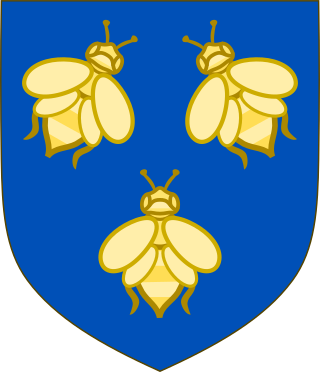
The House of Barberini is a family of the Italian nobility that rose to prominence in the 17th century Rome. Their influence peaked with the election of Cardinal Maffeo Barberini to the papal throne in 1623, as Pope Urban VIII. Their urban palace, the Palazzo Barberini, completed in 1633 by Bernini, today houses Italy's Galleria Nazionale d'Arte Antica.

The Galleria Nazionale d'Arte Antica or National Gallery of Ancient Art is an art museum in Rome, Italy. It is the principal national collection of older paintings in Rome – mostly from before 1800; it does not hold any antiquities. It has two sites: the Palazzo Barberini and the Palazzo Corsini.

The Palazzo Barberini is a 17th-century palace in Rome, facing the Piazza Barberini in Rione Trevi. Today, it houses the Galleria Nazionale d'Arte Antica, the main national collection of older paintings in Rome.

Antonio di Benedetto Aquilo degli Aquili, known as Antoniazzo Romano, was an Italian Early Renaissance painter, the leading figure of the Roman school during the latter part of the 15th century. He "made a speciality of repainting or interpreting older images, or generating new cult images with an archaic flavor", in particular by very often using the gold ground style, which was unusual by this period.
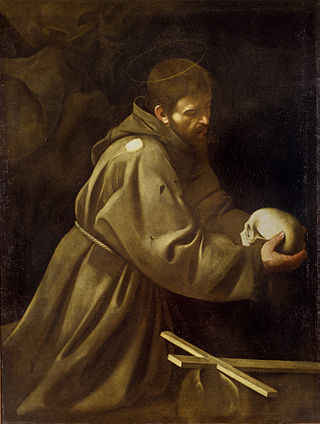
Saint Francis in Prayer is a painting from the Italian master Caravaggio, in the Galleria Nazionale d'Arte Antica in Rome.

Francesco Barberini was an Italian Catholic Cardinal. The nephew of Pope Urban VIII, he benefited immensely from the nepotism practiced by his uncle. He was given various roles within the Vatican administration but his personal cultural interests, particularly in literature and the arts, meant that he became a highly significant patron. His secretary was the antiquarian Cassiano dal Pozzo who was also a discerning patron of the arts. Francesco was the elder brother of Cardinal Antonio Barberini and Taddeo Barberini who became Prince of Palestrina.
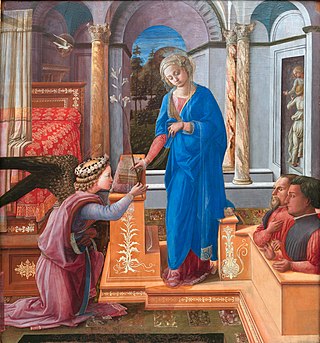
The Annunciation is an Italian Renaissance painting by Filippo Lippi. Dating to 1440–1445, it is housed in the Galleria Nazionale d'Arte Antica of Palazzo Barberini, Rome.

Antonio Barberini was an Italian Catholic cardinal, Archbishop of Reims, military leader, patron of the arts and a prominent member of the House of Barberini. As one of the cardinal-nephews of Pope Urban VIII and a supporter of France, he played a significant role at a number of the papal conclaves of the 17th century. With his brothers Cardinal Francesco Barberini and Taddeo Barberini he helped to shape politics, religion, art and music of 17th century Italy. He is sometimes referred to as Antonio the Younger or Antonio Barberini iuniore to distinguish him from his uncle Antonio Marcello Barberini.

Andrea Camassei was an Italian Baroque painter and engraver mainly active in Rome under the patronage of the Barberini.

The Palazzo Corsini is a prominent late-baroque palace in Rome, erected for the Corsini family between 1730 and 1740 as an elaboration of the prior building on the site, a 15th-century villa of the Riario family, based on designs of Ferdinando Fuga. It is located in the Trastevere section of the city, and stands beside the Villa Farnesina.

The Enthroned Madonna and Child is a painting by the Italian Renaissance painter Filippo Lippi. It is housed in the Galleria Nazionale d'Arte Antica of Palazzo Barberini, Rome.

The Statue of Pope Clement X is one of the final sculptural works executed by the Italian artist Gian Lorenzo Bernini. It depicts Pope Clement X in the act of benediction, and is housed in the Galleria Nazionale d'Arte Antica in the Palazzo Barberini, Rome.

Mariano Rossi was an Italian painter, persisting in what had become an anachronistic Rococo style amid an ascendant neoclassical environment. His placement legions of figures in a complex scenography and quadrature recalls the work of Pietro da Cortona.
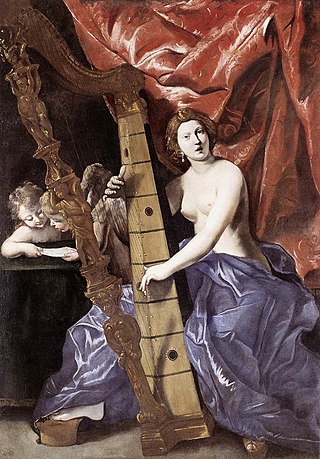
Venus plays the Harp is a painting by the Italian Baroque painter Giovanni Lanfranco. It is housed in the Galleria Nazionale d'Arte Antica at Palazzo Barberini, Rome.
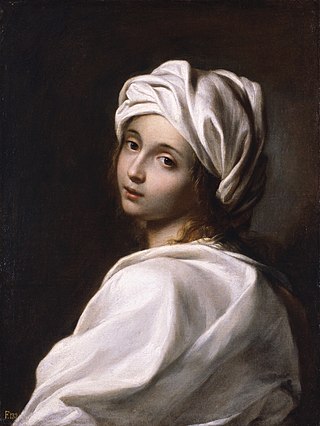
The Portrait of Beatrice Cenci is a painting once attributed to the Italian Baroque painter Guido Reni but now to Ginevra Cantofoli. It is housed in the Galleria Nazionale d'Arte Antica of Palazzo Barberini, Rome. The painting dealt with a controversial topic of Beatrice Cenci, a woman who was executed by Papal authorities, specifically Pope Clement VIII Aldobrandini.
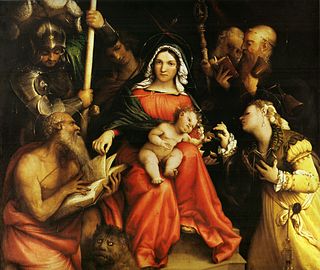
Mystical Marriage of St Catherine and Saints is an oil-on-panel painting by Lorenzo Lotto, signed and dated 1524, now in the Collections of the Galleria Nazionale d'Arte Antica, Rome, Italy.
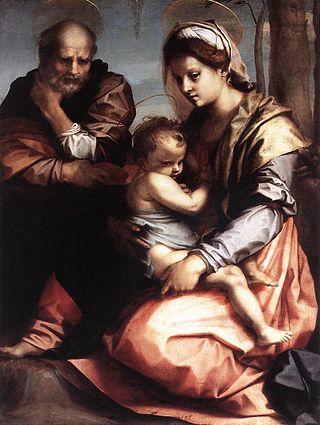
The Holy Family, an oil-on-wood painting of 1528–1529 by the Italian Renaissance painter Andrea del Sarto, is in the Galleria Nazionale d'Arte Antica in Rome.

The Banquet of a Rich Glutton is an oil on canvas painting by the Italian Baroque painter Mattia Preti, executed c. 1665. It is housed in the Pinacoteca of the Galleria Nazionale d'Arte Antica, in Rome.
The Vestal Claudia Towing the Ship Bearing the Statue of Cybele is a painting by the Italian Renaissance painter Benvenuto Tisi in the Galleria Nazionale d'Arte Antica at Palazzo Barberini in Rome, Italy.



















